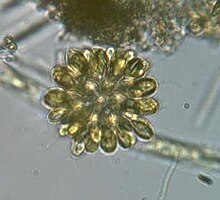Synurid
| Synurids | |
|---|---|

| |
| Synura sp. | |
| Scientific classification | |
| Domain: | |
| (unranked): | |
| Phylum: | |
| Class: | Synurophyceae Andersen, 1987
|
| Order: | Synurales Andersen, 1987
|
| Families | |
The synurids are a small group of heterokont algae, found mostly in freshwater.
Characteristics

They are covered in silicate scales and spines. These are formed on the surface of the chloroplasts, of which there are usually two, but sometimes only one divided into two lobes. The cells have two heterokont flagella, inserted parallel to one another at the anterior, whose ultrastructure is a distinguishing characteristic of the group. Both asexual and isogamous sexual reproduction occur.
Genera
There are two major genera included here, divided into species mainly based on the structure of the scales.
- Mallomonas are free-living individual cells, usually 50-100 μm in length. They have ornate scales and generally long spines.
- Synura occur as spherical colonies, with the cells oriented so that the flagella point outwards, each usually around 30 μm in length. The colonies are globular, rather than hollow, and spines are short if at all present.
Both are common plankton in lakes and ponds.
History
The synurids were originally included among the golden algae in the order Ochromonadales as the family Mallomonadaceae. They were formally defined as a separate group by Andersen in 1987, who placed them in their own class Synurophyceae, based on an earlier suggestion by Cavalier-Smith.
Chrysophyceae and Synurophyceae are part of a common clade.[1]
References
- ^ Grant J, Tekle YI, Anderson OR, Patterson DJ, Katz LA (March 2009). "Multigene Evidence for the Placement of a Heterotrophic Amoeboid Lineage Leukarachnion sp. among Photosynthetic Stramenopiles". Protist. 160 (3): 376–85. doi:10.1016/j.protis.2009.01.001. PMID 19282238.
{{cite journal}}: CS1 maint: multiple names: authors list (link)
External links
